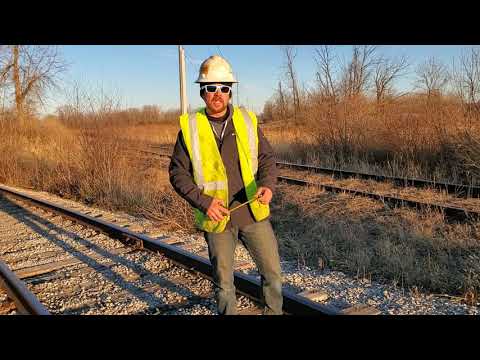Explore the World of Track Inspectors: Job Description and Salary
Track Inspector Job Description: A track inspector is responsible for examining and evaluating railway tracks to ensure they meet safety and quality standards. They inspect various components of the track, including rails, sleepers, ballasts, and switches, to identify potential defects or hazards. Track inspectors use specialized equipment such as gauges, lasers, and cameras to measure track alignment, gauge, and wear. They also assess the condition of bridges, tunnels, and other structures along the track. Additionally, track inspectors document their findings, prepare reports, and recommend necessary repairs or maintenance. They may collaborate with engineers and maintenance crews to develop and implement track maintenance plans. Attention to detail, knowledge of railway regulations and safety protocols, and the ability to work independently are essential qualities for this role.
Track Inspector Salary: The salary for a track inspector may vary depending on factors such as experience, location, and employer. On average, track inspectors earn around $55,000 to $70,000 per year. Entry-level positions typically offer lower salaries, ranging from $40,000 to $50,000 annually, while experienced track inspectors with advanced certifications or supervisory roles can earn upwards of $80,000 per year. Some employers may offer additional benefits, such as healthcare, retirement plans, and paid time off. It is worth noting that salaries can also differ between public and private railway companies. Overall, a career as a track inspector offers competitive compensation and opportunities for growth within the railway industry.

Track Inspector Job Description Template
Track Inspector Job Description
A track inspector is responsible for ensuring the safety and functionality of railway tracks. They examine tracks, switches, and other infrastructure to identify any defects or maintenance needs. Their main goal is to prevent accidents and ensure smooth operations of trains.
One of the key responsibilities of a track inspector is to conduct regular inspections of the railway tracks. They visually inspect the tracks for any signs of wear and tear, such as cracks or loose bolts. They also use specialized tools and equipment to measure the alignment and levelness of the tracks. Through these inspections, they can identify potential hazards and take necessary actions to address them.
Another important duty of a track inspector is to perform maintenance and repair work on the tracks. They may replace damaged or worn-out track components, such as rail ties or fasteners. They also ensure that the tracks are properly aligned and that switches and signals are in working order. Additionally, track inspectors are responsible for removing any debris or obstacles that may impede the train’s movement.
Attention to detail is crucial for a track inspector as they need to carefully examine the tracks and identify even the smallest defects. They must also have good problem-solving skills to come up with effective solutions for any issues they encounter. Additionally, physical fitness is important as the job often requires working outdoors, sometimes in challenging weather conditions.
In summary, a track inspector plays a vital role in maintaining the safety and efficiency of railway tracks. They conduct inspections, perform repairs, and ensure that tracks are in optimal condition for train operations.
Track Inspector Responsibilities
Track Inspector Requirements
How Much Does A Track Inspector Make?
Track Inspector Salary
| Experience Level | Annual Salary |
|---|---|
| Entry Level | $40,000 – $50,000 |
| Mid-Level | $50,000 – $60,000 |
| Experienced | $60,000 – $70,000 |
| Senior Level | $70,000 – $80,000 |
A track inspector is responsible for inspecting and maintaining railway tracks to ensure their safety and functionality. They examine tracks for any damage, such as cracks or breaks, and make necessary repairs or replacements. Additionally, they monitor track conditions, inspect and maintain track switches, and ensure compliance with safety regulations.
The salary of a track inspector varies based on their experience level. Entry-level track inspectors can expect to earn an annual salary ranging from $40,000 to $50,000. As they gain more experience and move into mid-level positions, their salary can increase to $50,000 – $60,000. Experienced track inspectors with several years of experience can earn between $60,000 and $70,000 per year. Senior-level track inspectors, who have extensive experience and expertise, can earn salaries ranging from $70,000 to $80,000 annually.
Track Inspector Salaries by Country
Top Paying Countries for Track Inspector
| Country | Average Salary (USD) |
|---|---|
| United States | 70,000 |
| Switzerland | 65,000 |
| Australia | 60,000 |
| Germany | 55,000 |
| Canada | 50,000 |
Track inspectors are highly valued professionals responsible for ensuring the safety and efficiency of railway tracks. Salaries for these professionals vary depending on the country they work in. According to the data, the top paying countries for track inspectors are the United States, Switzerland, Australia, Germany, and Canada. In the United States, track inspectors earn an average salary of $70,000 per year. Switzerland follows closely with an average salary of $65,000, while Australia offers an average of $60,000. Germany and Canada complete the list with average salaries of $55,000 and $50,000 respectively. These figures demonstrate the competitive compensation offered to track inspectors in these countries, reflecting the importance of their role in maintaining the safety and functionality of railway tracks.
A video on the topic Track Inspector
Video Source : Midwest Rail LLC
Interview Questions for Track Inspector
1. What are the primary responsibilities of a Track Inspector?
A Track Inspector is responsible for inspecting and monitoring railway tracks to ensure they are safe and in compliance with industry standards. They identify and report any defects or issues that may pose a risk to train operations.
2. What qualifications are required to become a Track Inspector?
To become a Track Inspector, you typically need a high school diploma or equivalent. Some employers may require additional technical training or certification in railway track inspection. Experience in the railway industry is also beneficial.
3. What tools or equipment do Track Inspectors use during inspections?
Track Inspectors use various tools and equipment to perform inspections, such as gauges, levels, measuring tapes, ultrasonic testing devices, and thermometers. They may also use specialized software or computer systems to record and analyze inspection data.
4. How do Track Inspectors ensure track safety?
Track Inspectors ensure track safety by conducting regular inspections to identify and address any defects, such as cracks, misalignments, or loose components. They follow established maintenance and repair procedures, and communicate any safety concerns to the appropriate personnel.
5. What are the common challenges faced by Track Inspectors?
Common challenges faced by Track Inspectors include adverse weather conditions that can impact track conditions, limited access to certain areas of the track, and the need to work within tight schedules to minimize disruption to train operations.
6. How do Track Inspectors stay updated on industry regulations and standards?
Track Inspectors stay updated on industry regulations and standards through ongoing training and professional development programs. They may attend workshops, seminars, or conferences to learn about new technologies, best practices, and regulatory changes.
7. What are the key qualities of a successful Track Inspector?
Key qualities of a successful Track Inspector include attention to detail, strong analytical skills, good communication abilities, physical stamina, and the ability to work independently as well as part of a team. They should also have a strong commitment to safety.
8. How do Track Inspectors document their findings?
Track Inspectors document their findings by completing detailed inspection reports. These reports include information about the condition of the track, any defects or issues identified, and recommended actions for maintenance or repairs. They may also take photographs or videos as supporting evidence.
9. How do Track Inspectors ensure compliance with regulatory requirements?
Track Inspectors ensure compliance with regulatory requirements by following established inspection protocols and guidelines. They stay updated on industry regulations and standards to ensure their inspections align with the required criteria. They also collaborate with other railway personnel to address any compliance issues.
10. How do Track Inspectors contribute to overall railway safety?
Track Inspectors play a crucial role in maintaining overall railway safety by proactively identifying and addressing track defects or hazards. Their inspections help prevent accidents, derailments, and other incidents that could jeopardize the safety of passengers, crew, and the general public.






